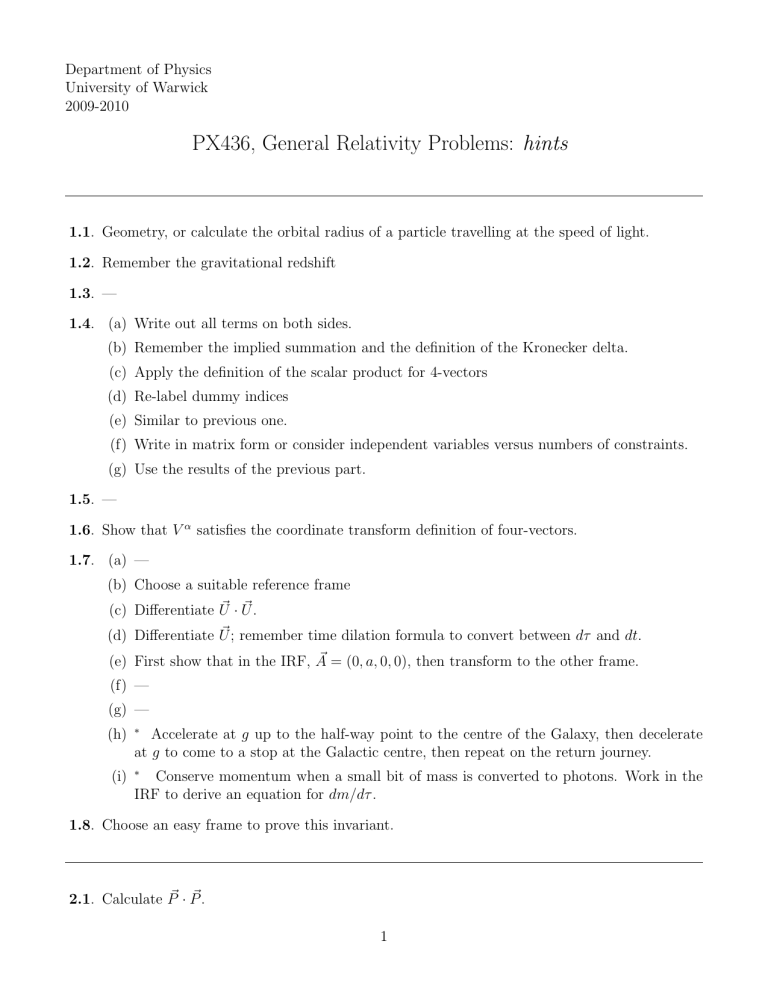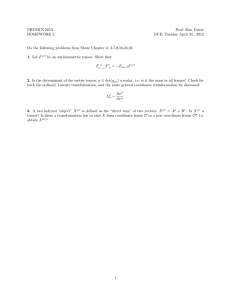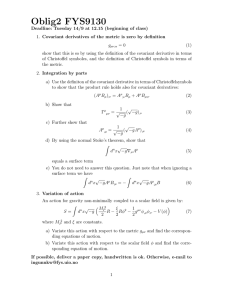PX436, General Relativity Problems: hints

Department of Physics
University of Warwick
2009-2010
PX436, General Relativity Problems: hints
1.1
. Geometry, or calculate the orbital radius of a particle travelling at the speed of light.
1.2
. Remember the gravitational redshift
1.3
. —
1.4
.
(a) Write out all terms on both sides.
(b) Remember the implied summation and the definition of the Kronecker delta.
(c) Apply the definition of the scalar product for 4-vectors
(d) Re-label dummy indices
(e) Similar to previous one.
(f) Write in matrix form or consider independent variables versus numbers of constraints.
(g) Use the results of the previous part.
1.5
. —
1.6
. Show that V α satisfies the coordinate transform definition of four-vectors.
1.7
.
(a) —
(b) Choose a suitable reference frame
(c) Differentiate
~ · U .
(d) Differentiate
~
; remember time dilation formula to convert between dτ and dt .
(e) First show that in the IRF,
~
= (0 , a, 0 , 0), then transform to the other frame.
(f) —
(g) —
(h)
∗
Accelerate at g up to the half-way point to the centre of the Galaxy, then decelerate at g to come to a stop at the Galactic centre, then repeat on the return journey.
(i)
∗
Conserve momentum when a small bit of mass is converted to photons. Work in the
IRF to derive an equation for dm/dτ .
1.8
. Choose an easy frame to prove this invariant.
2.1
. Calculate
~
·
~
.
1
2.2
.
(a) Calculate
~
·
~
.
(b) Remember the standard form for a plane wave in 3D
(c) Apply the Lorentz transformation to
~
.
2.3
. —
2.4
. Start with P
α
0
V frame.
α
0
, re-write in terms of transformed versions of components in the undashed
2.5
. Start from p
α in terms of a transformation of in the text of the question.
p
β
0
, and substitute for it in the equation given
2.6
. Substitute ~ p with sums over components time basis vectors and one-forms. Apply the linearity rules.
2.7
. Work out the Cartesian metric.
2.8
. Index raising/lowering.
2.9
. —
2.10
. Show that the appropriate transformations applied to it lead to a Kronecker delta in the dashed frame too.
2.11
. The key here is the word “vector”.
2.12
. Raise the index using the Minkowski metric.
2.13
. Feed in basis one forms.
Write out the equivalent relation in component form.
Think about the number of independent components.
2.14
. Remember the form of
~ in the IRF.
2.15
. Write out the component transformation of the stress-energy tensor. Last part: take nonrelativistic limit.
2.16
.
(a) —
(b) Write out separating the time from the spatial derivatives.
(c) Continuity equation.
2.17
.
∗
Consider a surface that everywhere lies outside of the mass; split the summation of the conservation relations into time and spatial components in order to transform expressions such as T
αi
,i into time derivatives. The last part is quite tough.
2.18
. Again, choose an easy frame to prove this invariant.
Put the gradient and four-velocity into component form.
2
3.1
.
(a) —
(b) Expand the implied sum.
(c) Well-known relation in EM
3.2
.
(a) Pythagoras.
(b) Elementary coordinate transform.
(c) —
3.3
.
(a) Express dθ in terms of dr
(b) Draw a sphere and identify a length that represents r .
3.4
.
(a) Trigonometry.
(b) Coordinate transform.
(c)
∗
Consider the form of the metric in the numerator.
3.5
.
∗
Move the density inside the derivatives in the second equation.
3.6
.
(a) Remember the general coordinate transformation relations and hence write down the transformation of the basis vectors. Partial derivatives commute.
(b) Write down the relation between the basis vectors as defined in the question from elementary geometry, test whether they satisfy the conditions.
(c) Should be obvious if you managed the previous part.
(d) Consider how you would extract the speed in the angular direction given vector components in an arbitrary coordinate system using scalar products. Remember that the basis vectors are not necessarily unit vectors.
4.1
. —
4.2
. —
4.3
. Adapt the example given in lectures.
4.4
. Calculate the metric coefficients, then apply the Levi-Civita formula.
4.5
.
(a) Obtain a Lagrangian given the metric from the previous question.
(b) —
4.6
.
(a) Coordinate transformation.
(b) —
(c) —
(d) Compare the equations above with the general equations of motion including the connection.
3
(e) Use the fact that ˙ is constant to switch from derivatives with respect to proper time to coordinate time t .
4.7
. Write out the derivative on both sides in full using the expressions from lectures.
4.8
.
(a) —
(b) Remember the four-acceleration is given by this relation in full to obtain the result.
~
= d ~ , or A
α
= DU
α
/Dτ . Write out
(c) —
4.9
.
∗
(a) Write down the transformation that must be obeyed, replace all components in the dashed frame by their equivalents in the undashed frame (apart from the connection in the dashed frame since you are trying to work out its transformation properties). Thus deduce the transformation properties of the connection.
(b) —
4.10
.
∗
The divergence term in Cartesian components is ∂ i
( ρv i ). You need to write it in covariant form. Take care with the component values in the polar coordinates coordinate basis.
Second part: integrate vertically through the disc.
4.11
.
∗
As in the previous question, you need to write an expression that (a) is a scalar and (b) is covariant. In this case the latter implies a correction term with the connection. See if you can simplify the connection term using the Levi-Civita expression before finally putting in the spherical polar metric.
5.1
.
(a) Write out middle expression in full and show that it equals the right-hand term.
(b) Raise the index α .
5.2
. Work with the fully covariant version, R
αβγδ
, and use the symmetries of handout 4 to show there is only one independent component, then work out the value of an example component by application of the formulae for the Riemann tensor and Levi-Civita connection.
5.3
.
(a) Contract each term on its covariant derivative.
(b) Contract FEs on α and β .
(c) —
(d) Look at the 00 component.
(e) Apply Gauss’ theorem.
(f) —
(g) Compare cosmological term with normal Newtonian gravity term.
5.4
. “Free-space” ≡ vacuum.
—
4
5.5
. * Algebra, algebra, algebra.
5.6
.
(a) Write out in component form. Break down the second derivative into two applications of a first derivative.
(b) Solve the differential equation.
5.7
. Use the chain rule to express d/dλ in terms of coordinate partial derivatives.
5.8
.
∗
Apply the formulae for the Riemann tensor and Levi-Civita connection. Drop second order terms as soon as you can.
5.9
. Remember that the covariant derivative of the metric = 0 and that it inertial coordinates, the connection, but not its derivatives, disappears.
5.10
. Apply symmetry/anti-symmetry conditions.
5.11
. Ditto.
5.12
.
∗
Ditto, but this is quite tough so think carefully.
6.1
. Should be straightforward.
6.2
. Remember to use the correct metric coefficients.
6.3
.
(a) Remember that photons move along null worldlines.
(b) Show that the time taken by a pulse does not depend upon its start time.
(c) Calculate the time between successive pulse arrivals at B relative to the time they are sent by A .
(d) —
(e) —
(f) —
(g) You can consider Lorentz and gravitational time dilations as separate effects.
6.4
. Integrate part (a) of previous question.
6.5
. Simplify as much as you can, then calculate whichever connection coefficients you need to get
A α . The acceleration felt by an observer is their proper acceleration.
6.6
. —
6.7
. Use the metric to raise or lower indices appropriately.
6.8
. —
7.1
.
(a) Apply the effective energy relation.
5
(b) The substitution r = r
0 sin
2
θ may help in the evaluation of the integral involved here.
(c) —
7.2
.
(a) —
(b) Use the condition that
~ · ~
= g
αβ x α x β = c 2 .
(c) —
(d) Particle speed = dl/dτ
0
.
7.3
.
(a) —
(b) Consider what height the inner maximum of the effective potential must be for capture to occur.
(c) —
7.4
. —
7.5
. Set initial radial and angular speeds by imagining an inwardly directed beam making angle α to the radial direction.
7.6
.
(a) Use the condition for circular orbits to eliminate h .
(b) —
(c) This is related to ˙ .
(d) Remember to account for the Earth’s timescale shift.
7.7
. Modify the derivation of the epicyclic frequency and thus the precession rate.
7.8
. This question is related to the orbit of Q 7.6
7.9
.
∗
Consider two events separated only in the radial coordinate and compute the acceleration terms from the geodesic deviation. You will need the components of the Riemann tensor.
7.10
. Use the angle to substitute for ˙ φ and consider the condition necessary for the light to escape.
7.11
.
∗
(a) Calculate the frequency of small oscillations.
(b) —
(c) —
(d) Special case, but similar to part (a)
7.12
. Consider the signs of the various terms.
8.1
.
(a) Approximate the path as two straight lines, as shown in the question and then apply geometry.
6
(b) —
8.2
. Approximate the peak of the potential up to the quadratic term, differentiate with respect to the affine parameter.
8.3
. Express dφ/dt in terms of quantities whose values you know.
8.4
. —
8.5
.
(a) Proper distance dl 2 = − ds 2 for dt = 0.
(b) Light travels along null paths.
8.6
. —
8.7
. Remember that in Kruskal coordinates photons travel at ± 45
◦ to the axes.
8.8
.
(a) Apply the usual coordinate transformation to the metric
(b) Consider null paths
(c) —
9.1
. —
9.2
. The crucial step is to use the correct scaling for ρ with the size of the universe, R .
9.3
. —
9.4
. —
9.5
. Apply the formula for the angular diameter distance.
9.6
.
9.7
. Combine the flux from the luminosity distance calculation with the angular diameter relation.
9.8
.
9.9
. The density is the sum of the various components, each with their own scaling with size which relates to redshift.
9.10
. A slight modification of the derivation from lectures.
9.11
. Related dV to dR .
9.12
. Remember the fundamental equation relating z to the expansion factor.
9.13
. Use the Euler-Lagrange approach to derive the radial equation of motion.
10.1
.
(a) Drop terms higher that first order asap.
7
(b) Restrict to β = γ = 0.
(c) Use l 2 = − g ij x i x j .
(d) —
10.2
. Estimate the amplitude generated; calculate the amount of energy needed to move the masses violently enough.
10.3
.
(a) Work out the total orbital energy as a function of M and a .
(b) Integrate.
(c) —
(d) —
(e) —
10.4
. Remember that the wave should be traceless. This does not come automatically from the ij but has to be imposed as a correction to the solution.
10.5
. Show that the first and third terms cancel, and simplify the fourth term, using the Lorenz condition in both cases.
10.6
.
∗
(a) Argue by analogy with the general formula for the Newtonian gravitational potential.
(b) Just apply the general equation.
(c) Need to invert trace reverse equation.
(d) Remember definition of h
αβ
.
8



